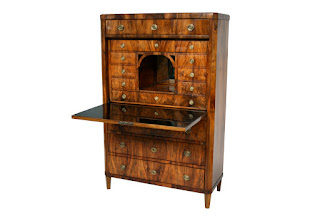OldFox.info is a personal Knowledge Management blog for comment, criticism, parody, research, reference, text-searchable, personal clipboard. Comments, suggestions, contributions are invited. email: oldfox-at-gmail.com
Sunday, March 10, 2013
Biedermeier
main page - collection - overview - [ history ] - restoration - contact
Biedermeier refers to work of literature, music, the visual arts and furniture in the period between the years 1815 (Vienna Congress), the end of the Napoleonic Wars, and 1848, the year of the European revolutions and contrasts with the Romantic era which proceeded it. It was the age of the Austrian Chancellor Metternich, Prince Metternich, whose diplomacy and influence dominated much of the post-Napoleonic period. It was a period of conservative politics in reaction to the horrors and chaos of the French Revolution and Napoleons wide-reaching conquests. Liberalism and popular movements were viewed askant and suppressed. It was the heyday of the secret police.
But it was also a time of great creativity. Great names like Beethoven, Schubert, Johann Strauss the Elder and Joseph Lanner dominated the Viennese music scene. Despite censorship, theatre and literature flourished. It saw growing industrialisation and the resulting migration from rural to largely urban life. It was also the beginning of the Railway Age in almost all European countries. The Biedermeier period came to an end in the revolutions of 1848. At the same time the so-called Metternich System of conservative and diplomatic conferences with the major powers to try and repress or maintain order by acting concertedly in Europe, also came to an end.
Biedermeier applied at first in a joking spirit. It is believed to have been named for the worthy, bourgeois-minded "Papa Biedermeier," a humorous character featured in a series of verses by Ludwig Eichrodt, published in Fliegende Blätter. The Biedermeier period found expression in comfortable, homelike furnishings, simple in design and inexpensive in material, fitting the requirements of the people in a time of little wealth following the Napoleonic Wars. Biedermeier designs were simplified forms of the French Empire and Directoire styles and of some 18th-century English styles, and were often elegant in their utilitarian simplicity.
Vienna was in many ways a spiritual and artistic center, strong enough to blend the most varied impulses into its own synthesis. Already in the production of Empire-style furniture, the Vienna furniture builders had found their definitive expression. Their more cherished and fantasy-filled designs differed clearly from those of French taste and the latter's German derivatives. Viennese furniture makers worked securely and solidly, which is reflected in the charming home furnishings of the artisans' best quality. Austrian furniture is lighter and designed for livability, elegance and private life. Viennese Biedermeier furniture can be seen more than elsewhere in its relationship to and partial transition from Empire style, and it shows itself in especially striking, artistically mature products of high quality.
In 1816 there were 875 independent master cabinetmakers in Vienna, in 1823 already 951. Some ran genuine factories, the best-known and most influential of them was Josef Danhauser, who was already employing 100 workers in 1808. Danhauser sold not only funiture in his factory, but also home furnishings such as drapes, carpets, clocks and even glassware. The Viennese Museum of Applied Arts (MAK) has over 2500 of Danhauser's catalogue drawings. They show the never-ending fantasy and decors. Nowadays Biedermeier became very popular due to its timeless design and therefore collectors enjoy Biedermeier furniture as lasting appreciation. Its high functionality and simple forms suits today's modern sense of living.
Content and Images © 2006-2011 biedermeier-vienna.com
Subscribe to:
Post Comments (Atom)







No comments:
Post a Comment